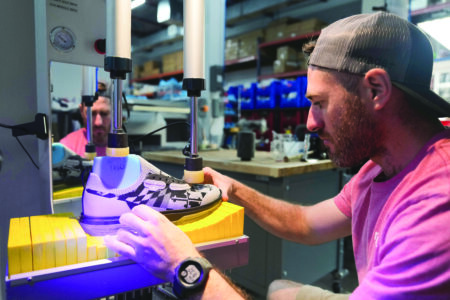Children are going to love a snorkel bucket

Sabin, Davis, Hetrick, Anderegg, Macalady, Walker, Darling and Katers
Snorkeling opens up a whole new world of exploration for children. The gear is relatively inexpensive and takes a little practice. Younger children can feel left out, but there is a way for them to see what is happening underwater without even getting their face wet. They will feel included in the family fun until they are skilled enough to put on the gear.
Snorkel bucket
To help young children who have good enough balance to walk in water you can create a snorkel bucket and guide them around with a hand on their shoulder to steady them as they look down. You will need an empty small plastic pail or large plastic ice cream container, a sharp knife, a couple of large rubber bands knotted in a circle to fit tightly around the circumference of the pail, plastic wrap, and duct tape.
Cut out the bottom of the pail making the hole slightly smaller than the bottom to add stability to the pail. Cover the hole and the entire side with a large piece of plastic wrap. Keep the plastic wrap in place by carefully and slowly sliding the rubber bands ¾ of the way up the side of the pail. This procedure works best with two people.
Once the bucket is assembled practice using the bucket in very shallow water. Show children how to gently push the snorkel bucket into the water without letting any water get inside. The pressure of the water will cause the plastic to become a convex lens similar to a magnifying class so objects will look larger than they really are. The bucket is quite durable but keep extra supplies around to maintain it.
Exploring
Young children enjoy looking at their feet and footprints in the sand. They might find the tracks of clams, snails, and birds like herons that have hunted in the night. The children might be a bit unsteady because they are looking down.
Children also like to find toys and other planted objects in the water. Museums have beautiful rocks and fool’s gold that children can collect, reuse, and won’t harm the environment if lost in the water. To help the little explorer you can cordon off a small area where you have planted a few objects to find.
As children learn to slowly explore the water they can team up with someone with a small net and catch snails, clams, a minnow, water bug, live dragonfly nymphs (harmless if not handled) or nymph skeletons which only look frightening. If children are afraid, give the creatures names like Sammy snail or point out why dragonflies are friends. These are old useful maneuvers.
For more see grandparentsteachtoo.blogspot.com and wnmufm.org/Learning Through the Seasons.





